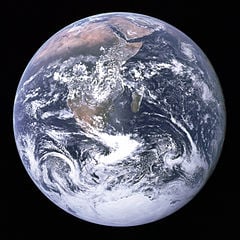Breath of life: Air.
Contemplative point 6: On our being aware, the common denominator education is what gets us there. Education: A must!
Fact: Today, 50 percent of the world’s human inhabitants live in cities.
By the mid-century mark, the figure is expected to grow to two-thirds or 67 percent.

Okay, so if world population expands to 9 billion by 2050 (the number projected), and if the urban-to-rural ratio is two-thirds-to-one-third, this has as many as 6 billion people residing in cities by that time, the same number that existed in the world right around the year of 1997.
Fact: “WHO [World Health Organization] air quality model confirms that 92% of the world’s population lives in places where air quality levels exceed ‘WHO’s Ambient Air quality guidelines’ for annual mean of particulate matter with a diameter of less than 2.5 micrometres (PM2.5). WHO guideline limits for annual mean of PM2.5 are 10 μg/m3 annual mean.
“PM2.5 includes pollutants such as sulfate, nitrates and black carbon, which penetrate deep into the lungs and in the cardiovascular system, posing the greatest risks to human health,” the WHO reported in a Sept. 27, 2016 news release.
Also in the release:
“‘This new model is a big step forward towards even more confident estimates of the huge global burden of more than 6 million deaths – 1 in 9 of total global deaths – from exposure to indoor and outdoor air pollution,’ said Dr Maria Neira, WHO Director, Department of Public Health, Environmental and Social Determinants of Health. ‘More and more cities are monitoring air pollution now, satellite data is more comprehensive, and we are getting better at refining the related health estimates.’”
The race/pressure is on
It will be a huge undertaking for cities to accommodate the numbers of people expected to be accommodated. In other words, cities will have their work cut out for them.
What with world population staying its present upward and uninterrupted course, we can either plod along like we’re currently doing, and by that I mean maintain a-business-as-usual (do nothing different) stance; one that obviously doesn’t take into consideration the anticipated ramifications to the planet caused from global warming, or, in erring on the side of caution, we can take a much more proactive approach and plan and prepare now.
As I write this I can take comfort in knowing that such steps are being taken.
Consider the following, also from the same WHO news release referenced above.
“This fall WHO is rolling out BreatheLife, a global communications campaign to increase public awareness of air pollution as a major health and climate risk. BreatheLife is led by WHO in partnership with the United Nations Environment Programme (UNEP)-hosted Climate and Clean Air Coalition to Reduce Short-lived Climate Pollutants. The campaign stresses both the practical policy measures that cities can implement (such as better housing, transport, waste, and energy systems) and measures people can take as communities or individuals (for example, to stop waste burning, promote green spaces and walking/cycling) to improve our air.”
If you notice, nearly all of the “practical policy measures” mentioned above and others that focus on the areas of agriculture, climate, the economy, education, health/healthcare, infrastructure, land use and mobility, is what this entire “Terms and conditions: Our impact on Earth; its impact on us” series is all about.
More importantly I think is that the overarching message that has to be impressed upon us is to not just look at each of the individual elements in isolation but to consider them in the holistic sense so as to make marked progress the outcome that is more likely to be realized. An “in thing” that could be the new normal if smarter heads prevail.
And, speaking of smarter heads, education – as it relates, the means of bringing to the fore the “conditions” we’re facing – is, as it were, square one.
This concludes the 8-part “Terms and conditions” series.
Image above: NASA
This post was last revised on May 10, 2020 @ 6:46 a.m. Pacific Daylight Time.
– Alan Kandel